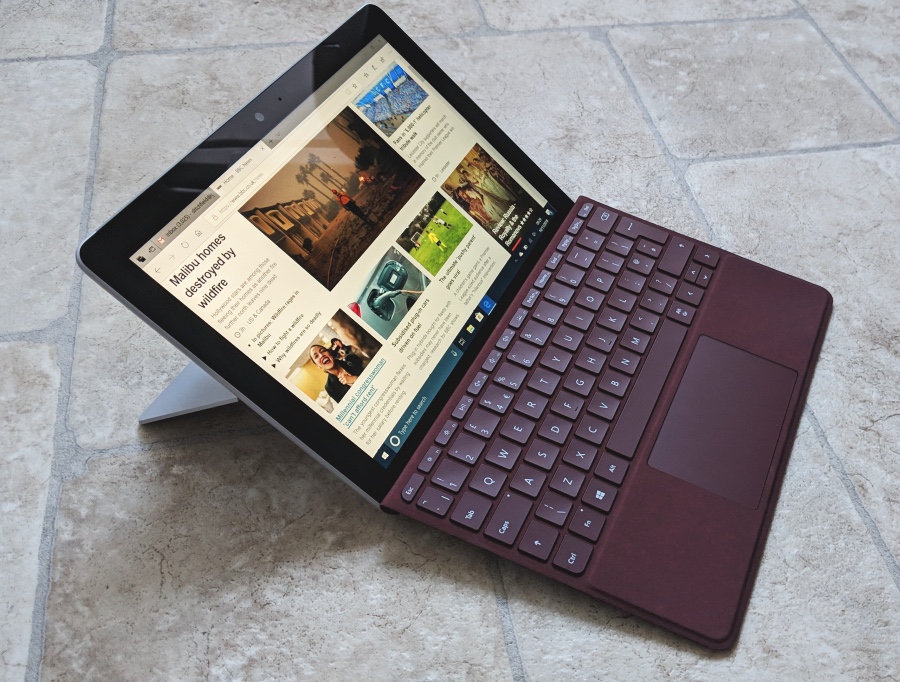From my verdict:
This last review part has glossed over a few of the subtleties of my experience, but do go back and read the preceding review parts for the full details. The Surface Go is - absolutely - a full 'Wintel' PC and as such has its quirks and occasional frustrations. If you've used Windows for the last few decades then you already know what to expect, what to look out for!
But the quirks can't take away from what is a unique form factor that has caught my heart. It's just so flexible and so portable. With this (including Type Cover), a suitable hub and a smartphone to tether to, you're equipped for almost everything and are carrying a total weight of much less than a kilogram, which is a doddle. It's a laptop, it's a tablet, it's a portable TV, it's a workhorse, it's an artist's canvas. Essentially the Surface Go is whatever you want it to be.
Yes, the specifications are compromised, to meet the form factor and low price point, but the sacrifices are dramatically outweighed by the unique selling points of the Surface Go. Consider me a big fan.
From Daniel's article:
In December 2019, Qualcomm announced two new Snapdragon processors for Windows 10 PCs. The Snapdragon 7c and 8c are positioned for entry-level and mid-range PCs competing against Intel's lackluster Atom and Pentium processors (and even AMD).
At the time, I speculated that a Surface Go 2 could potentially use one of the new chips as Qualcomm hinted at sub-$400 PCs running the Snapdragon 7c chipset (the slightly more powerful 8c is for laptops in the $500-800 range).
Now, we have the first evidence that these chips would let Microsoft hit the $400 price-point for Surface Go 2 if they so choose. The First Snapdragon 7c laptops are very affordable. These two new laptops — the JP.IK Turn T101 ($300), and the Positivo Wise N1212S with inking ($575) — were recently announced along with Microsoft's continued annual push into growing education markets. What makes both laptops unique is they are the first to utilize a Qualcomm Snapdragon 7c processor — which itself is newsworthy.
The news is also our first look at real-world pricing for 7c devices, and $300 is quite low. School laptops tend to have thick bezels, use a lot of hard plastic, lack high-end specs like IPS displays and are generally not attractive. They're meant to take beatings from school kids for years and bought en masse for entire classrooms. But the ability for Qualcomm to hit that low of a price is noteworthy (and a direct threat to Intel and AMD long term, despite lingering growing pains with ARM on Windows).
The original Microsoft Surface Go is high-end by comparison to the JP.IK Turn T101. The Go's 1800 x 1200 IPS display with inking is one of the most expensive parts of the tablet. The same applies to the front-facing speakers, magnesium chassis, hinged kickstand, MicroSD slot, and Windows Hello infrared camera. It's remarkable Microsoft can push Surface Go down to the $400 range even without the extra $100 Surface Go Keyboard.
But with the Snapdragon 7c, the costs of that chip compared to an Intel Pentium Gold or even new AMD Athlon mobile processors seems comparable. That's important if Microsoft is exploring going with ARM for a Surface Go 2.
...Of course, Microsoft is likely testing various chipsets and scenarios, making Qualcomm hardly a shoo-in for a Surface Go 2. But Surface Go — like those new education laptops — is aimed at similar markets. Microsoft originally spun the Surface Go as the perfect device for "schools, kids, and enterprise".
While the push for ARM-based PCs has mostly focused on business, it is now evident education markets are ripe for them too. That's a lot of overlap with Surface Go, and with the right price, connectivity, and slimmer hardware profile, an ARM-based Surface Go 2 could be a very intriguing device. What's more exciting is Microsoft could even offer a higher-tier 5G Surface Go 2 with the Qualcomm Snapdragon 8c – similar to how Intel has Core i5, and i7 processors.
Daniel goes into much more detail on Qualcomm benchmarks versus those existing Intel devices, so do click through to read the full article.
Sadly my Surface Go was a review unit and had to go back, but I've been this close to re-buying one for myself several times since. And if my Surface Pro ever gave up the ghost, I'd jump on a Go in a heartbeat - it's just so light and compact. Making the prospect of a cheaper, better Surface Go 2 very attractive indeed.
Could I live with ARM-compiled UWP apps and emulation for Win32? I think I might be able to do just that. After all, I've survived on recent trips with just my trusty NexDock 2!
Your comments welcome.

